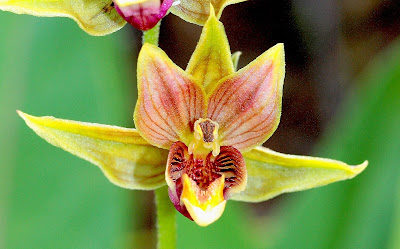Epipactis gigantea, also called as Stream orchid, Giant helleborine, Chatterbox is found growing in wet gravelly and sandy stream shores and bars....
Epipactis gigantea, also called as Stream orchid, Giant helleborine, Chatterbox, Amesia gigantea, Arthrochilium giganteum, Cephalanthera kokanica, Epipactis americana, Epipactis gigantea f. rubrifolia, Epipactis pringlei, Helleborine gigantea, Limodorum giganteum, Peramium giganteum, Serapias gigantea, is a species of the genus Epipactis. This species was described by David Douglas ex William Jackson Hooker in 1839.
IDENTIFY EPIPACTIS GIGANTEA - STREAM ORCHID - GIANT HELLEBORINE - CHATTERBOX
Epipactis gigantea is native to western North America from British Columbia to central Mexico. It is found growing in wet gravelly and sandy stream shores and bars, may occur in riparian willow, box elder, and river birch woodlands or in chaparral, seepages, marshes, wet cliffs, hot springs at elevations of 0-3000 meters above sea level.
Stream orchid is a medium to large sized, cool to cold growing terrestrial which reaching to 1.4 meters tall. The stems are leafy and which arise from short rhizomes to form colonies. The leaves are 4-14, cauline, without petioles clasping the stem, and up to 20 cm long. Lower leaves are ovate while the upper are lance-shaped. The herbage is rough to the touch or smooth and glabrous.
Giant helleborine blooms in the spring and summer from the terminal, to 1 meter long, 2-32 flowered raceme. The flowers are rather showy with leafy, lanceolate bracts. Sepals greenish to rose-colored with rose-colored to purple veins. Petals pale pink to rose-colored to orange with red or purple veins. Lip marked with red or purple, strongly veined. Two very distinct color forms of this species have been published: Epipactis gigantea forma rubrifolia, with deep red stems and leaves, and E. gigantea forma citrina, with lemon-yellow flowers.
EPIPACTIS GIGANTEA - STREAM ORCHID - GIANT HELLEBORINE - CHATTERBOX CARE AND CULTURE
Cultural information should only be used as a guide, and should be to be adapted to suit you. Your physical location; where you grow your plants, how much time you have to devote to their care, and many other factors, will need to be taken into account. Only then can you decide on the cultural methods that best suit you and your plants.
Light:
Epipactis gigantea are best positioned in an area that attracts partial sunlight as they will thrive better in shady spaces. These plants can be planted in full sunlight on condition that the substrate is prevented from becoming dry in summer.
Humidity:
Stream orchid needs the humidity level of 40-70%. Too dry air has a negative effect on the development of the plant: its growth is inhibited, and the leaves begin to turn yellow and dry out. The higher temperature, the higher the humidity should be, and the higher the humidity, the more often and longer it is necessary to ventilate the room where the plants are contained, otherwise the probability of rotting and various kinds of fungal diseases.
If the humidity levels are consistently too low, consider buying a humidifier to increase the humidity level. Another way of increasing humidity is by setting your plants on trays filled with pebbles or gravel and with water, but plants should not be in contact with the water.
Temperature:
Giant helleborine grow best at summer days average of 22-25 °C, and nights average 17-19 °C, with a diurnal range of 5- 8°C. Winter days average 14-16 °C, and nights average 9-11 °C, with a diurnal range of 5-7 °C.
Substrate and growing media:
Epipactis gigantea tolerate many conditions as long as pH is neutral, between 5.5 and 7 . They are best planted in moist well-drained soil of clay, chalk or loam within an acidic, alkaline or neutral PH balance. At the time of planting you may wish to supplement native soil with a generous amount of compost to maintain good moisture levels in the summer and to promote better drainage during the winter. You can use many media such as pumice gravel, coarse sand , loam and clay (max 5 %) , peat, fen soil , sphagnum , coco peat, oyster shells . Organics preferable less than 20 %.
Repotting is done once in two to three years in autumn, winter and spring when still dormant, or in late spring when growths have reached maturity.
Watering:
Stream orchid require consistently moist soil to thrive and so therefore it is vital to water plants regularly throughout active growth and during prolonged periods of dry weather. Do not let your plants dry out at any time of the year, even during autumn and winter. Soil may not be too wet in full summer, risk of anaerobic soils. Warm compost with standing water is very dangerous! Rainwater is advisable, otherwise good quality tap water chlorine poor. Good oxygen rich water is essential.
Watering is directly dependent on the temperature of the content, the higher it is, the more often it needs to be watered. When watering, excess water should flow freely from the pot, since stagnation of water both inside the pot and in its pan can very quickly lead to rotting of the roots and the lower part of the plant.
Fertilizer:
Giant helleborine is an easy strong growing orchid, that needs more fertiliser as other species, so one may use a good quality chemical fertiliser in growing phase, dissolved in the water as a surplus. As basic fertiliser you can use slow release grains once a year, 10 grains per mature plant in spring when shoots break through the surface.
Rest period:
During the winter, Epipactis gigantea persists in rhizome form and develops new shoots in the spring. They are the very cold-resistant and do not require any special protection in winter. It is possible to propagate by seed or by division once the plants are well-established. Highly proliferative, these orchids will quickly form colonies of several hundred head following the successive growth and dormancy cycles.















COMMENTS